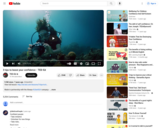
View full lesson: http://ed.ted.com/lessons/3-tips-to-boost-your-confidence-ted-edMade in partnership with the Always #LikeAGirl campaign.When faced with a b...
- Subject:
- Education
- Health Education
- Material Type:
- Other
- Date Added:
- 10/04/2023

View full lesson: http://ed.ted.com/lessons/3-tips-to-boost-your-confidence-ted-edMade in partnership with the Always #LikeAGirl campaign.When faced with a b...
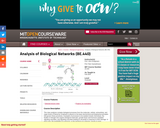
This class analyzes complex biological processes from the molecular, cellular, extracellular, and organ levels of hierarchy. Emphasis is placed on the basic biochemical and biophysical principles that govern these processes. Examples of processes to be studied include chemotaxis, the fixation of nitrogen into organic biological molecules, growth factor and hormone mediated signaling cascades, and signaling cascades leading to cell death in response to DNA damage. In each case, the availability of a resource, or the presence of a stimulus, results in some biochemical pathways being turned on while others are turned off. The course examines the dynamic aspects of these processes and details how biochemical mechanistic themes impinge on molecular/cellular/tissue/organ-level functions. Chemical and quantitative views of the interplay of multiple pathways as biological networks are emphasized. Student work will culminate in the preparation of a unique grant application in an area of biological networks.
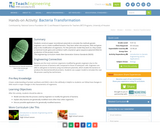
Students construct paper recombinant plasmids to simulate the methods genetic engineers use to create modified bacteria. They learn what role enzymes, DNA and genes play in the modification of organisms. For the particular model they work on, they isolate a mammal insulin gene and combine it with a bacteria's gene sequence (plasmid DNA) for production of the protein insulin.
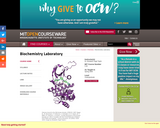
" The course, which spans two thirds of a semester, provides students with a research-inspired laboratory experience that introduces standard biochemical techniques in the context of investigating a current and exciting research topic, acquired resistance to the cancer drug Gleevec. Techniques include protein expression, purification, and gel analysis, PCR, site-directed mutagenesis, kinase activity assays, and protein structure viewing. This class is part of the new laboratory curriculum in the MIT Department of Chemistry. Undergraduate Research-Inspired Experimental Chemistry Alternatives (URIECA) introduces students to cutting edge research topics in a modular format. Acknowledgments Development of this course was funded through an HHMI Professors grant to Professor Catherine L. Drennan."

This resource is useful as a kinesthetic activity to reinforce the content on nucleic acids. Students can create a model that shows the three dimensional aspect of DNA and understand the helix shaped molecule and its components.

A web adventure featuring characters from the popular CSI series in which students participate in completing a crime scene investigation using proper forensic technique.

The goal of this course is to teach both the fundamentals of nuclear cell biology as well as the methodological and experimental approaches upon which they are based. Lectures and class discussions will cover the background and fundamental findings in a particular area of nuclear cell biology. The assigned readings will provide concrete examples of the experimental approaches and logic used to establish these findings. Some examples of topics include genome and systems biology, transcription, and gene expression.

Study and discussion of computational approaches and algorithms for contemporary problems in functional genomics. Topics include DNA chip design, experimental data normalization, expression data representation standards, proteomics, gene clustering, self-organizing maps, Boolean networks, statistical graph models, Bayesian network models, continuous dynamic models, statistical metrics for model validation, model elaboration, experiment planning, and the computational complexity of functional genomics problems.

This lab allows students extracting DNA from their own cheek cells.
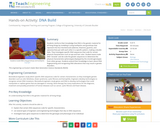
Students reinforce their knowledge that DNA is the genetic material for all living things by modeling it using toothpicks and gumdrops that represent the four biochemicals (adenine, thiamine, guanine, and cytosine) that pair with each other in a specific pattern, making a double helix. They investigate specific DNA sequences that code for certain physical characteristics such as eye and hair color. Student teams trade DNA "strands" and de-code the genetic sequences to determine the physical characteristics (phenotype) displayed by the strands (genotype) from other groups. Students extend their knowledge to learn about DNA fingerprinting and recognizing DNA alterations that may result in genetic disorders.
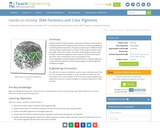
Students perform DNA forensics using food coloring to enhance their understanding of DNA fingerprinting, restriction enzymes, genotyping and DNA gel electrophoresis. They place small drops of different food coloring ("water-based paint") on strips of filter paper and then place one paper strip end in water. As water travels along the paper strips, students observe the pigments that compose the paint decompose into their color components. This is an example of the chromatography concept applied to DNA forensics, with the pigments in the paint that define the color being analogous to DNA fragments of different lengths.

The web quest and accompanying handout takes students through the experiments of Oswald Avery, Fredrick Griffith, Alfred Hershey, & Martha Chase chronicling the events that led to the discovery that a gene is made of DNA.

As a class, students work through an example showing how DNA provides the "recipe" for making our body proteins. They see how the pattern of nucleotide bases (adenine, thymine, guanine, cytosine) forms the double helix ladder shape of DNA, and serves as the code for the steps required to make genes. They also learn some ways that engineers and scientists are applying their understanding of DNA in our world.
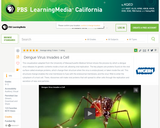
In this visualization adapted from the University of Massachusetts Medical School, discover the role that dengue viral proteins play in a human cell as the virus prepares to replicate.

DNA Interactive is a great website with interactive lessons about genetics, biotechnology and DNA. Created by the DNA Learning Center, the website allows students to learn the basics of DNA and genetic manipulation through interactive modules, articles and mini-games. Additionally, there are teacher lessons, activities and answer keys available on the website that can be modified to fit your curriculum.
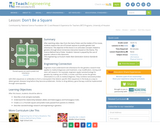
After watching video clips from the Harry Potter and the Goblet of Fire movie, students explore the use of Punnett squares to predict genetic trait inheritance. The objective of this lesson is to articulate concepts related to genetics through direct immersive interaction based on the theme, The Science Behind Harry Potter. Students' interest is piqued by the use of popular culture in the classroom.

" This is an advanced course on modeling, design, integration and best practices for use of machine elements such as bearings, springs, gears, cams and mechanisms. Modeling and analysis of these elements is based upon extensive application of physics, mathematics and core mechanical engineering principles (solid mechanics, fluid mechanics, manufacturing, estimation, computer simulation, etc.). These principles are reinforced via (1) hands-on laboratory experiences wherein students conduct experiments and disassemble machines and (2) a substantial design project wherein students model, design, fabricate and characterize a mechanical system that is relevant to a real world application. Students master the materials via problems sets that are directly related to, and coordinated with, the deliverables of their project. Student assessment is based upon mastery of the course materials and the student's ability to synthesize, model and fabricate a mechanical device subject to engineering constraints (e.g. cost and time/schedule)."
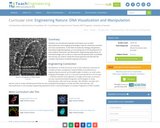
Students are introduced to genetic techniques such as DNA electrophoresis and imaging technologies used for molecular and DNA structure visualization. In the field of molecular biology and genetics, biomedical engineering plays an increasing role in the development of new medical treatments and discoveries. Engineering applications of nanotechnology such as lab-on-a-chip and deoxyribonucleic acid (DNA) microarrays are used to study the human genome and decode the complex interactions involved in genetic processes.

Under the "The Science Behind Harry Potter" theme, a succession of diverse complex scientific topics are presented to students through direct immersive interaction. Student interest is piqued by the incorporation of popular culture into the classroom via a series of interactive, hands-on Harry Potter/movie-themed lessons and activities. They learn about the basics of acid/base chemistry (invisible ink), genetics and trait prediction (parseltongue trait in families), and force and projectile motion (motion of the thrown remembrall). In each lesson and activity, students are also made aware of the engineering connections to these fields of scientific study.
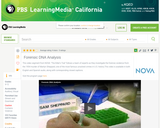
This video segment from NOVA: "The Killer's Trail" investigates the potential for DNA evidence to solve murder cases, even those from the distant past.